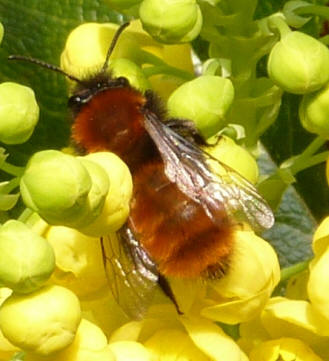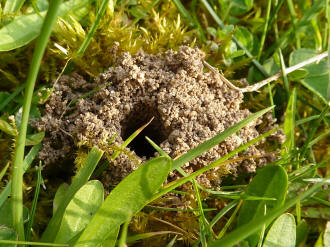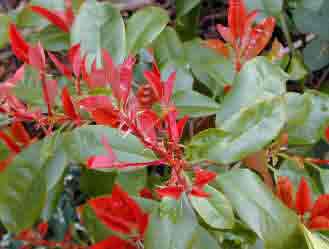Mining Bees in Lawns - Digger or Burrowing Bees,
Mining bees are hardly worth writing about should not be considered as a lawn problem - unless there is a large colony of them. Highly unlikely.
They are small bees that live alone,
borrowing into the lawn to make a nest for themselves. They are
sometimes mistakenly identified at flying ants - mainly because of
their size and the fact that the excavate fine soil which
resembles a minute ant hill.
They do not have a sting of any consequence, and certainly not like that of the honey bee. They will rarely be present in anything other than 'just a few' and mining bees simply 'burrow' a small hole in the lawn, leave a very small mound of sandy soil which is best just scattered in dry conditions.
If - as they rarely do - they are present in larger numbers, then brush off the mounds in April/May. This is the time of year that the over-wintered adult appears and starts to think about building a nest for itself. They are 'loners' in that they have their own small nest, and do not colonise in community nests such as honey bees and wasps.
Mining Bees are happy to live in a loose gathering of like minded bees, and seem to be happy sharing food sources. However, they live most of their life alone - the underground nest being home for itself and its young.
 They are not harmful in the garden generally - nor lawn. They prefer
a sandy or light soil, and sparsely vegetated. But they are also happy
to populate a well kept lawn area.
They are not harmful in the garden generally - nor lawn. They prefer
a sandy or light soil, and sparsely vegetated. But they are also happy
to populate a well kept lawn area.
They gather pollen as their main source of food, and this is stored underground in their nest - ready for the young grub - pupa - to feed on after hatching from the egg laid by the adult mining bee. Being pollen gatherers, they do much good by way of pollination in the garden, so should be considered as a friend in the garden. They do not eat plant material nor feed on roots when they burrow. Their normal choice of home patch will not in any case have many roots!
Most mining bees are smaller than the honey bee, and are varied in colour, together with which some seem to have shiny hair less bodies (probably the mining wasp!). There are several types of mining bees - the most common being the Tawny Mining Bee.
Tawny Mining Bee collecting Pollen.
Mining bees are interesting subjects to watch. The fact that they are not aggressive helps! It is normally the female that burrow her own nest, in which she will lay her eggs, which once they are hatched, will feed on the stock of pollen that has been built up by the mother.
The males of the Mining Bees are a little bit show off, performing aerial displays near the colony of nests. Each female is her own queen, and does not have to rely on the Queen Bee present in the large nests of the honey bees.
 They
are very active in spring and early summer, so are desirable as
pollinators for fruit and vegetable garden - in the legume crops in
particular.
They
are very active in spring and early summer, so are desirable as
pollinators for fruit and vegetable garden - in the legume crops in
particular.
They are not the group of hover wasps that are also beneficial - but by eating harmful insects.
Mining bees are said to be beneficial by way of aeratng the soil. This is a minimal aspect, and does not preclude the normal lawn aeration operations that still need to be carried out!
The nest of the solitary loner - the Tawny Mining Bee.
It would be foolhardy to treat this visitor as a pest. The nest excavations are at most, a little inconvenient. If present in large numbers, then simply brush them off on a dry day.
There should be room in your garden for such insects. To kill the mining bees with chemicals would be entirely without justification!
Best Selling Gardening Products
Popular Gardening Sections

Problems
Identify Weeds in The Garden - How to deal with weeds. Diseases and Pest which harm your garden and plants, learn how to prevent, deter and erradicate your garden problems.
Garden Problems
Pruning
Pruning Guide. Shrubs flower better with correct pruning. Many illustrations and examples of what to do - and when. Includes evergreens, roses, flowering shrubs, spring flowering shrubs and pruning for stem effect. This is our most viewed and comprehensive section,
Pruning
Gardening Businesses
Gardening Businesses listed in the UK counties and USA states. County and State Listings of businesses involved in Garden supplies and services. If you wish to be added to the Directory, please send us your information. Having problems, use the search box
Businesses
Gardening
In this section you will learn about Gardening Basics, Containers, Landscaping, Propagation and Soil.
Gardening
Gardening Gifts
Gardening Gifts and Reviews, Read Before you Buy
- Gardening Gifts Ideas
- Gifts For Her
- Gifts For Men
- Power Tool Gifts
- Cheap Gifts
- Personalised Gifts
- Wildlife Gifts
- Family Gifts



